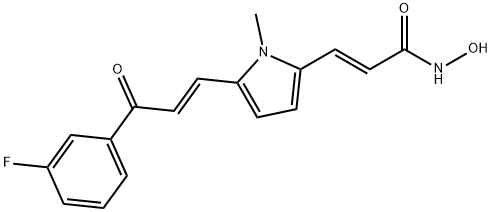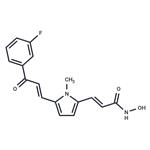While class I HDACs are localized predominantly within the nucleus, class II HDACs shuttle into and out of the nucleus in response to intracellular signaling. Class IIa HDACs, which includes HDAC4, 5, 7, and 9, commonly act as corepressors and play diverse roles in cell biology. MC 1568 is a selective inhibitor of class IIa HDACs, with greater than 170-fold selectivity over class I HDACs, including HDAC1. It has been used in cells (1-10 μM) and in mice to elucidate the roles of class IIa HDACs in cell proliferation and differentiation, apoptosis, myogenesis, adipogenesis, and fibrosis.
While class I HDACs are localized predominantly within the nucleus, class II HDACs shuttle into and out of the nucleus in response to intracellular signaling. Class IIa HDACs, which includes HDAC4, 5, 7, and 9, commonly act as corepressors and play diverse roles in cell biology. MC 1568 is a selective inhibitor of class IIa HDACs, with greater than 170-fold selectivity over class I HDACs, including HDAC1. It has been used in cells (1-10 μM) and in mice to elucidate the roles of class IIa HDACs in cell proliferation and differentiation, apoptosis, myogenesis, adipogenesis, and fibrosis.[Cayman Chemical]
A selective class II (IIa) histone deacetylase (HDAC II) inhibitor. It exhibits tissue-selective inhibition between members of class II acetylases in vivo, particularly in skeletal muscle and the heart. It arrests myogenesis through the stabilization of myocyte enhancer factor 2D (MEF2D)-HDAC3/4 complex.
ChEBI: 3-[4-[3-(3-fluorophenyl)-3-oxoprop-1-enyl]-1-methyl-2-pyrrolyl]-N-hydroxy-2-propenamide is a carbonyl compound.
MC1568 is a selective class II (IIa) histone deacetylas (HDAC II) inhibitor.


